 I will never forget this accident.
I will never forget this accident.
On a Sunday I got a call from a client, asking that I come immediately to their distribution center several hours away. Literally a wall of improperly stacked product had collapsed due to crushed cartons. The falling wall created a domino effect that knocked down eight aisles of three-level pallet racking. Fortunately no one was injured.
As we perform warehouse assessments for clients, we routinely see many issues that need to be rectified:
- Overhead pallets extending well beyond racking crossbeams
- Discarded trash in the base of the racking systems
- Slip and trip hazards, i.e. aisles of broken wooden pallets, trash, discarded shrink wrap
- Excessive pushing, pulling or lifting by employees as they pick, process and move product
- Countless racking support risers and crossbeams damaged by forklift operators to the point of compromising the racking system’s strength
On the other hand I have worked in many larger facilities that take safety and housekeeping to a whole other level of professionalism and pride. If you’ve taken any Operations Summit facilities tours, you’ve seen some great examples of safety and efficiency at Innotrac, eBay, Gilt and UPS, to name a few. They don’t tolerate these conditions for a minute, and neither should you.
We are all aware of the potential costs of accidents and injuries and want the best for our employees. However, I want to encourage you to take a step back and objectively address safety standards, training programs and practices. Here are seven things to consider:
Housekeeping is an indicator of a DC’s management attitude and the center’s efficiency
We have never seen a well-managed center that was a housekeeping mess. Efficient and well-managed centers deal with safety and housekeeping as part of their productivity and quality improvement standards. This starts at the top – when management is on the floor and picks up trash, it sends a message to the rest of the staff to do the same. Lean standards embrace these concepts too.
Warehouse safety standards and mandatory training are key
Do you have a formal written set of warehouse safety standards? New employees are at a significantly higher risk than veterans. It pays to have periodic mandatory training programs and refresher courses, which creates a culture and workplace where people are looking out for each either. Material handling equipment and product safety companies, as well as OSHA, have great resources to get you started.
Improving safety involves other departments
As you work to reduce the shipping costs that dimensional weight prices are adding to operations, you need to make sure you don’t reduce the carton strength so material can’t be stacked safely or as ship-alone products. While this sounds obvious, we see many centers where this is a concern. Work with merchants and purchasing to find the right balance.
Developing safer forklift operations
I singled out this area because OSHA reports about 100 warehouse employees are killed and 95,000 injured every year in forklift accidents. Studies show that about 50% of the most serious accidents in DCs involve forklifts. Are your forklift operators fully trained? Do you have bumpers at the end of aisles to protect racking systems? Do you proactively replace damaged racking?
Drug testing and physical exams
Twenty-two states and the District of Columbia have legalized medical marijuana to some degree. Large warehouse employers may be way ahead of small-to-medium-sized companies in making drug testing mandatory for new employees. The vice president of operations for a large multichannel company told me they have added physical exams for new employees, which I think is smart for both the employer and the employee. What are your company’s policies? How should they be changed?
Creating a culture of safety awareness
Tracking and posting your safety record in high-traffic areas will increase awareness. Post your drug-free workplace policies too. Investigate near misses, find out what lessons were learned and feed this information back to supervisors and employees to prevent injuries.
Applying ergonomics
Here are two examples from recent assessments. In one, rather than using power material handling exchange (MHE) equipment, workers used movable ladders to pick full cartons with both hands up to 12 feet off the floor. In another, workers used non-motorized flatbed carts to pick oversized products and pull orders to the shipping stations. Both companies fortunately invested in proper equipment to reduce injury. How can you change tasks in your warehouse and reduce fatigue and risk?
Improving your workplace safety lowers health insurance and workmen’s compensation claims, reduces absenteeism and cuts down on fatigue which can make workers susceptible to injury to themselves and others. Safety in the DC is everyone’s responsibility, but it starts at the top.
Curt Barry is president of F. Curtis Barry & Company
